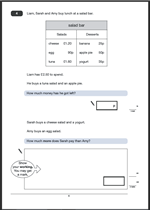Multiplication of money by a single digit is very much like multiplying a 3-digit number by a single digit, but, of course, the decimal point needs to be included. It would normally be expected to answer these types of question using the standard written method.
The first 8 questions are set out in the standard way but it is important that the second set of questions, from 9 to 15 should be set out in the correct way and not attempted as shown.
When marking these check that the working is shown, especially that the numbers have been carried across. It is often a good idea for children to check the answers to this type of question by using a calculator. (If they just use the calculator to find the answer this is quite obvious as there is no working shown!)
This page any many others can be found in our Four Rules section.

